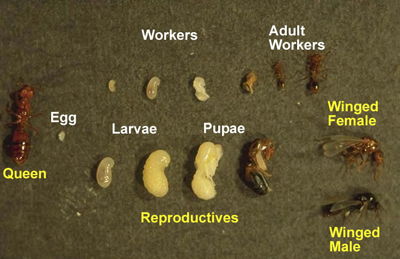Castes
Fire ants are social insects that are organized unlike many other insect pests. Imported fire ant colonies consist of the brood and several types (castes) of adults. The whitish objects often found at the tops of the mounds are actually the ant’s immature stages—the eggs, larvae and pupae. Types of adult castes are:
- winged males (distinguished from the females by their smaller heads)
- red-brown (RIFA), black or dark brown (BIFA and HIFA) winged females
- one or more queens (wingless, mated females)
- workers
Worker ants are wingless, sterile females. They protect the queen by defending the nest from intruders, by feeding the queen only food that the workers or larvae have eaten first, and by moving the queen from danger. They also forage and care for the developing brood.

Newly Mated Queen
The winged forms, or reproductives, live in the mound until their mating flight, which usually occurs in the late morning and afternoon soon after a rainy period. Mating flights are most common in spring and fall. Males die soon after mating, while the fertilized queen lands and walks around to find a suitable nesting site, sheds her wings, and begins digging a chamber in which to start a new colony. Sometimes, several queens can be found within a single nesting site.
A newly-mated queen lays about a dozen eggs. When they hatch 7 to 10 days later, the larvae are fed by the queen. These larvae will develop into small worker ants that will feed the queen and her subsequent offspring. Later on, a queen fed by worker ants can lay from 800 to 1,000 eggs per day if needed. Larvae develop in 6 to 10 days and then pupate. Adults emerge 9 to 15 days later. The average colony contains 100,000 to 245,000 workers and up to several hundred winged forms and queens. Queen ants can live 7 years or more, while worker ants generally live about 5 weeks, although large workers can survive much longer.
There are two kinds of imported fire ant colonies—the single queen and multiple queen forms. Workers in single queen colonies are territorial. Workers from multiple queen colonies move freely from one mound to another, which has resulted in a dramatic increase in the number of mounds per acre. Areas infested with single queen colonies contain 40 to 150 mounds per acre (rarely more than 7 million ants per acre). In areas with multiple queen colonies, there may be 200 or more mounds and 40 million ants per acre.
Mounds
Imported fire ants build mounds in almost any type of soil, but prefer open, sunny areas such as pastures, parks, lawns, meadows and cultivated fields. Mounds can reach 18 to 24 inches in height, depending on the type of soil. Often mounds are located in rotting logs and around stumps and trees. Colonies also can occur in or under buildings.
Colonies frequently migrate from one site to another. A queen needs only half a dozen workers to start a new colony, and can build a new mound several hundred feet away from their previous location almost overnight. Flooding causes colonies to leave their mounds and float until they can reach land to establish a new mound. Colonies also can migrate to indoor locations.
- Mounds consist of many interconnected galleries and chambers.
- Workers can excavate galleries and chambers to a depth of 30 to 40 centimeters.
- There are a few tunnels that can reach the water table.
- Lateral foraging tunnels can extend up to ten meters from the mound.
- Queen and brood are moved throughout the mound in response to temperature.
- On cold days, the colony moves deep into the mound. As the mound becomes warmer, the ants move closer to the surface.
Foraging
- A majority of fire ant foraging occurs between 72 degrees F and 90 degrees F.
- Foraging tunnels radiate underground from the mound. Fire ants exit the mound via these tunnels which may first open to the surface about 12 inches from the mound’s edge.
- When small amounts of food are found workers return directly through the opening from which they came.
- When fire ants encounter large pieces of food, ants leave pheromone trails as they return to the mound with a sample of the food to recruit more ants.
- Fire ants are omnivorous; their main food source is other invertebrates, but they also feed on plants, sap, honeydew and dead animals.
- Queens, workers and first through third instar larvae can only consume liquids.
- Oils are stored in the crop and post pharyngeal gland.
- Water soluble liquids are stored only in the crop.
- Liquids may be transferred several times between foragers before they are transferred to nurse ants and eventually to the queen and larvae.
- Solids greater than 0.88 microns are strained from liquids and formed into pellets by workers.
- Pellets and solid food are given only to fourth instar larvae which break down the solids and digest the proteins that are distributed to other larvae and queens.